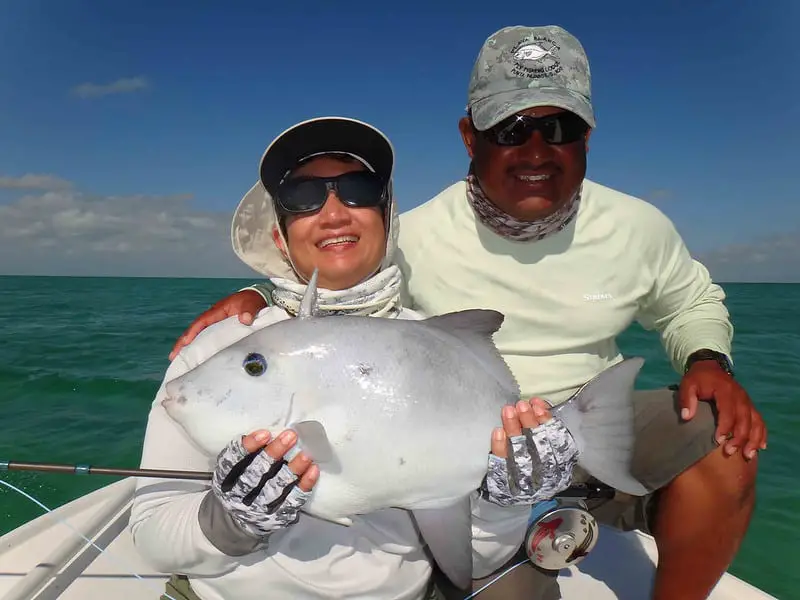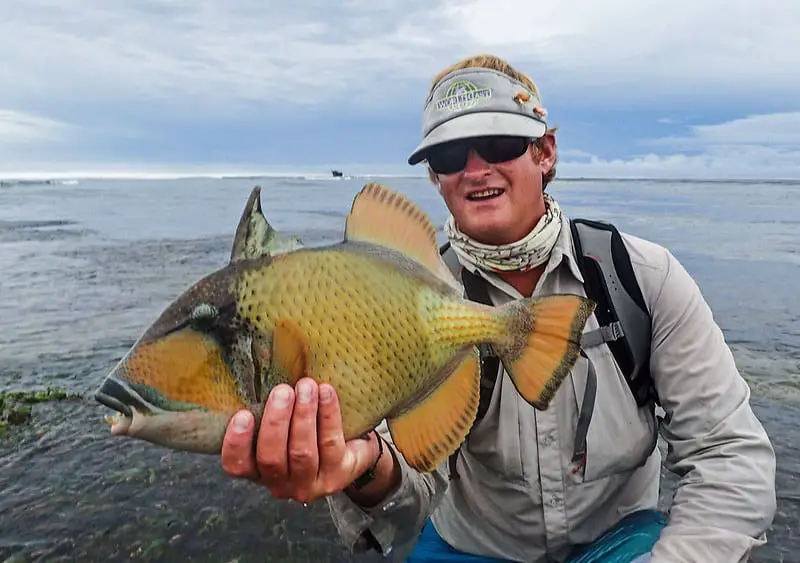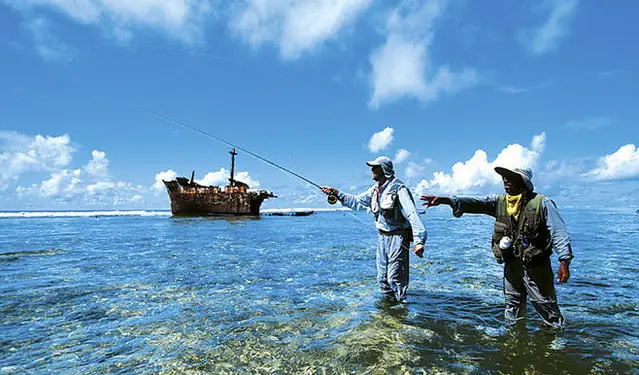Disclosure: Some posts contain affiliate links, which earn us a commission if you make a purchase through them. Positive Fishing © participates in various affiliate networks including the Amazon Services LLC Associates Program.
If you speak to any fly fishing guide or angler who has spent time going after triggerfish they will tell you that they have a love-hate relationship with these fish.
Fly fishing for triggerfish is incredibly visual as you are wading at the shins to knee-deep water and casting at tailing fish, which is why it’s so addictive. But, there is a ton of fun frustration that comes along with it.
Triggerfish can be incredibly picky, spooky, and downright annoying on some days, and on other days, all they want to do is eat your fly. This behavior only adds to one’s love-hate feelings about triggerfish.
Having been a guide in Seychelles for a few years and during that time, spent hours stalking triggerfish, I’m going to give you my personal insight into how to catch a triggerfish on the fly.
What Are Triggerfish?

Triggerfish are from the Balistidae family of marine fishes. They are recognized by their oval-shaped bodies and there are almost 40 species of triggerfish. They are generally found in the tropical warmer waters around the world.
Tip: The name of the Triggerfish comes from the way the first two dorsal fins retract when the rear spine is lowered, hence a “triggered mechanism”.
The most common targetted Triggerfish is the Grey Triggerfish which can be found in the waters around the southern united states. My target Triggerfish in the Indian Ocean are the Moustache triggerfish, Picasso Triggerfish, and the Yellow Margin Triggerfish.
Where Do Triggerfish Live?
You will find triggerfish all around the Pacific and Indian Oceans as well as in the Caribbean, and specifically in the warmer parts of these oceans, close in latitude to the equator. Fishing for Florida Triggerfish is a popular species for North American fishermen.
Triggerfish tend to live on the edge of reefs, spending their time between the drop-off and the shallower sections inside, as well as in the lagoons of coral atolls. They are very intelligent fish that create nests that they are quite protective of.
If you have ever snorkelled or dived with triggers, you’ll know how aggressive they can be when you get near their nest, so much so that they might give you a little nibble.
What Do Triggerfish Eat?
The main diet of a triggerfish consists of small crabs, shrimps, and small baitfish. Since triggers aren’t that big in size, they tend to eat smaller prey but if you have ever seen a trigger’s teeth, you’ll notice they have bone-crushing ability.
They use these teeth to crush open things like clamshells, and triggers even have the intelligence to take a clam and place it down, then pick up a rock, and smash it open. These are smart fish, most of the time.
Tip: Whilst the largest Triggerfish is the Stone Triggerfish, the Moustache Triggerfish (also known as the Titan Triggerfish) is known as the most aggressive of the Triggerfish and they can inflict some very serious injuries.
What Fly Fishing Gear Do I Need For Triggers?
Since triggers aren’t the biggest of fish on the flats, you can leave your 12 weight at home but when you hook them, their immediate reaction is to run into the nearest hole. If you want to land a trigger, your gear is going to need to be able to stop them before they get into a hole, and before they break your tippet on some coral.
Here is my recommended fly fishing setup for triggerfish:
- 9 weight fast action saltwater fly rod
- 9 weight saltwater fly reel with a good drag
- 250 yards of 30-50 lb backing
- 9 weight tropical saltwater fly line
- Leader & tippets from 18 – 25 lb breaking strain
- A range of crab and shrimp flies
As you can see, this is a similar setup to what you would use for bonefish except the tippet is a bit stronger and this is so you can stop the fish from going into a hole. The added breaking strain also ensures that you have a better chance of the tippet not being shredded on some coral.
What Flies Do I Need For Triggerfish?
Triggerfish can be notoriously fussy about what fly they want to eat but in some cases, they will simply eat whatever fly you throw at them. The best fly patterns for triggerfish resemble a crab or a shrimp pattern, similar to what you would throw at a permit or a bonefish, the key difference being the hooks.
What Hooks That Can Survive Triggerfish
Whatever fly you choose to cast at a triggerfish, make sure it’s tied on a serious hook as they can literally snap poor-quality hooks in half with their incredibly strong teeth. The best hook to tie a trigger fly on is a Gamakatsu Wide Gape SL12 size 2/0. These Japanese hooks are incredibly strong, super sharp, and have the right gape.
Alphlexo Crab Fly Pattern
The Alphlexo crab was designed by master fly tier Alec Gerbec who came up with this pattern while being the head guide at Alphonse Island in Seychelles. This crab fly has brought more permit and triggerfish to hand than any other I know of.
Make sure to have a range of different colored and different weighted Alphlexo Crabs in your box so you can match the color to the bottom you’re fishing on and adjust the weight for the depth of water.
Excellent colors include white, tan, olive, and orange and you should match white for sand, olive for turtle grass, and tan or orange for rocky/coral areas.
Olly’s The Mutant Fly Pattern
This fly was tied by another veteran Seychelles guide, Oliver Thompson and it’s a leggy version of a tanned shrimp. This fly is excellent for triggerfish as its lower profile allows it to land with a soft plop and being quite light is perfect for skinny water.
Again, make sure to carry this fly in a range of weights and colors so that you can match your fly choice to the fishing scenario you see in front of you.
Other Flies
There are lots of other flies that will work well for triggerfish, as long as they imitate a crab or a shrimp and are tied on the right hooks. Here are the other recommended flies to have with you when going after triggers on the fly.
- Weapon Of Mass Destruction
- Turneffe Crab
- Kraken Crab
- Avalon Shrimp
- Sydney’s Shrimp
Check out my article on the Best Flies To Use For Predator fish here! This article is an in-depth review of my personal picks for catching predators on the fly.
Now that you know what gear you’ll need, let’s work out how you find triggers around reefs and atolls, and when it’s best to target them.
Tip: Another name for the Triggerfish is the “filefish”, due to its coarse abrasive scales.
How To Find Triggerfish On The Flats

Triggers always tend to live around coral and this can be in a lagoon or in the surf zone near to the outer reef. But, they are also very happy to sit deep near the bottom so how do you find triggers when they are tailing and ready to see a fly?
Tides Matter More Than Anything
Triggerfish are not the best swimmers and they will leave areas with a lot of stronger current and head deep to find a spot that is easier and safer for them to move around in. This means you only have a small window in the tide to target triggerfish on and it differs between spring tides and neeps.
Spring Tide
Spring tides create a lot more water movement than neep tides and therefore a lot more current but there is still a window with low water movement that works for triggers.
On a spring tide, you should plan your day so that you arrive at the surf zone around 1.5 hours before low tide and stay there until about an hour after. The water should be shin to knee-deep and the current should be minimal.
Neep Tide
Neep tides bring little or no water movement at all and this is a tide triggerfish love as they can be on a flat all day long. When looking for triggers on a neep tide, stick to shallower areas within the lagoon such as coral fingers.
Lagoon Triggers vs Surf Triggers
When choosing whether to target triggers in the surf or in the lagoon, I would generally recommend the surf zone. In the surf, there is a lot more going on in terms of waves and noise which gives the triggers time to work out if your fly is real or not, and hear it land.
Best Tips To Catching A Triggerfish On Fly

Once you have found a tailing triggerfish there are some key things you will need to do between casting, stripping, and setting the hook, which will make hooking the fish far more likely.
How To Cast To Triggerfish
Annoyingly, triggerfish don’t have the best eyesight meaning you will have to cast your fly close enough for them to even see it. But, on the other hand, if you land your fly too close to them or they hear it land, you’ll spook them and they will swim off never to be seen again.
You want to land your fly very softly 3-5 feet away from the trigger, either in front of the fish or to the side. This is the ideal zone where the fish will see the fly but not get spooked by it landing. Once the fly has landed, let it sink before stripping.
Use The Current
When choosing where to cast your fly you should also use the current to your advantage. By landing your fly up current of the fish, you can let the fly swing in the current into the trigger’s eye line, making it much easier not to spook the fish and to ensure it sees the fly.
The Strip & Chase
Once the fly lands and has sunk, start stripping short and slowly. When the trigger sees the fly, it will either spook or start following it.
Triggers will either eat the fly mid-water on the strip or off the bottom if you allow them to tail on it, and both methods work well.
Once a trigger is on your fly, either keep stripping until you feel it eat the fly or strip a few times to get it agitated and then let it sink, allowing the fish to tail and eat the fly.
Setting The Hook & The Fight
To set the hook you only need to keep stripping, and one or two strips are enough. Do not lift your rod as you will lose the fish instantly. Once hooked, the trigger is going to run into the nearest hole it can find and you need to stop it without breaking your tippet.
Hold the rod high to ensure no coral cuts you off, and try to hold the fish too, as much as you can, without breaking your tippet. You can also follow the fish to reduce tension as you fight. After about 5 minutes, the fish will give up and you can land it.
When landing a trigger, never put your fingers near their mouths or they will bite your finger down to the bone. Hold them by the tail and under the belly, and use pliers to remove the hook.
Can You Eat Triggerfish?
Triggerfish are generally safe to eat but like all reef fish, they can be toxic due to the presence of Ciguatera. This toxin is found in the algae in some tropical reefs, where triggerfish and most other reef fish spend most of their time.
The Triggerfish flesh is enjoyed by many due to its clean, white meat which has a slightly sweet taste somewhat similar to the crab.
Winding Up
Thanks very much for reading my article, I hope you enjoyed it and are now ready to catch your first trigger on a fly. These fish are highly addictive to fish for and are loads of fun to catch, but they will drive you insane at the same time – you have been warned!
You can learn more about on fly fishing the flats from a skiff which is one of the most exciting styles of fishing on the ocean.
- Top Tips For Fishing With Feathers - January 15, 2025
- How To Fish For Flounders: Tips, Rigs, & Baits - March 27, 2024
- Fortis Wraps Fishing Sunglasses: The Affordable Option For Anglers - January 25, 2024


